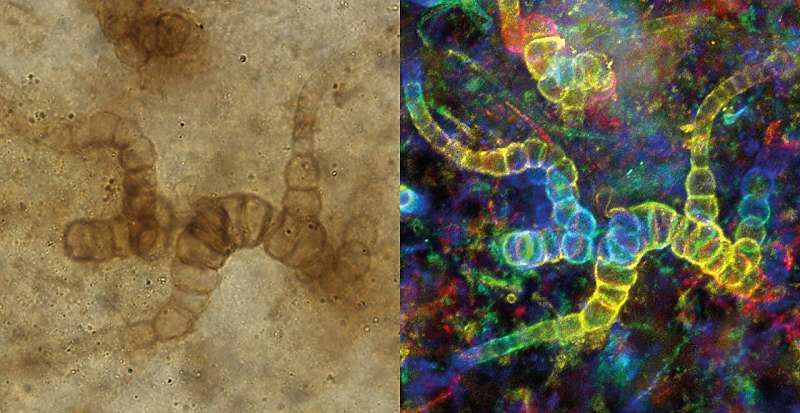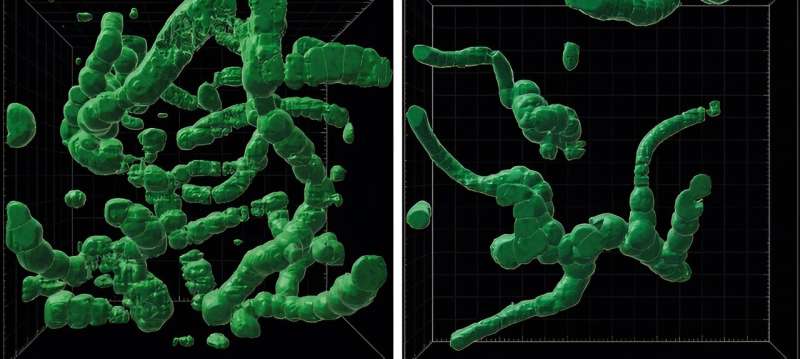This article has been reviewed according to Science X's editorial process and policies. Editors have highlighted the following attributes while ensuring the content's credibility:
fact-checked
peer-reviewed publication
trusted source
proofread
Ancient bacteria species among the first of its kind to colonize land

A species of bacteria that lived 407 million years ago would have flourished among early land plants.
Detailed 3D reconstructions of fossils discovered in Scotland are helping scientists to understand more about how microbial life affected early terrestrial ecosystems.
Cyanobacteria evolved early in our planet's history and played a significant role in shaping life as we know it.
These tiny microorganisms have been well documented in marine rocks, but scientists are trying to understand more about how they first colonized land.
Langiella scourfieldii is a species of cyanobacteria which is part of the Hapalosiphonaceae family and grew among early land plants more than 400 million years ago in the Early Devonian.
A new study published in iScience reveals that L. scourfieldii is the oldest species of the Hapalosiphonaceae known to have colonized land. It would have thrived in soils, freshwater and hot springs, much like its living relatives do today.
Dr. Christine Strullu-Derrien, a Scientific Associate at the Museum and lead author of the study says, "With the 3D reconstructions, we were able to see evidence of branching, which is a characteristic of Hapalosiphonacean cyanobacteria. This is exciting because it means that these are the earliest cyanobacteria of this type found on land."
What are cyanobacteria?
Cyanobacteria are an ancient group of microorganisms. Their fossils are among the earliest ever discovered, with the oldest widely accepted ones dating to around 2 billion years ago.
Today, they are one of the largest and most important groups of bacteria. They live in and around aquatic environments virtually everywhere on Earth, including oceans, freshwater, damp soil, and even Antarctic rocks.
Although small and typically unicellular, cyanobacteria often grow in colonies large enough to see with the naked eye and are known for their extensive blooms that turn the water's surface blue-green.
These tiny organisms have played a significant role in shaping the evolution of life. They photosynthesize in a similar way to plants and are responsible for helping to create our oxygen-rich atmosphere.
Around 2.4 billion years ago, masses of photosynthesizing cyanobacteria initiated the Great Oxygenation Event, when oxygen began to replace other gases like methane in the atmosphere. This led to what many scientists have described as Earth's first mass extinction as organisms that were adapted to anaerobic life began to die out.
Cyanobacteria probably originated in freshwater environments, so scientists believe they started to colonize land early in their history.
"Cyanobacteria in the Early Devonian played the same role that they do today," says Christine. "Some organisms use them for food, but they are also important for photosynthesis. We have learnt that they were already present when plants first began colonizing land and may have even competed with them for space."

How was Langiella scourfieldii discovered?
L. scourfieldii was first discovered in 1959 alongside two other species from a rock fragment found in the Rhynie Chert fossil site in Aberdeenshire.
The original descriptions were based on specimens in the Museum's collections, but more recently, similar specimens discovered in the collections of the Sorbonne University in Paris were found to be from the same species.
"The three species of cyanobacteria described in 1959 were described from a small piece of rock that is very difficult to photograph and study," Christine says.
"Fortunately, we found new samples from the Rhynie Chert containing cyanobacteria that we could study in more detail using the confocal microscope."
One of the main characteristics of this type of bacteria is the presence of what is known as "true branching." This occurs when individual bacteria grow alongside each other in a line, with some lines breaking off in different directions to create a branching structure.
While remains of cyanobacteria are relatively common in the Rhynie Chert, many do not display this true branching. By finding it in L. scourfieldii, researchers could confirm the bacteria's presence in this ecosystem.
What did the Rhynie Chert look like in the Early Devonian?
More than 400 million years ago, the landscape of Aberdeenshire would have looked considerably different from today.
Much of Earth's landmass was located in the Southern Hemisphere. Scotland lay just south of the Equator and would have experienced a tropical to sub-tropical climate.
The Rhynie Chert, meanwhile, would have been an area of sandy flatland with shallow pools of fresh to brackish water. Volcanic activity and hot springs in the area would mean that it likely resembled the modern Yellowstone Nation Park.
That said, its biodiversity would have looked very different, as the Early Devonian was before forests and vertebrates started to become dominant on land.
Instead, the focus of life would have been on moist rocks near pools of water. These would have been covered by microbial mats consisting of bacteria, algae and fungi.
As the soil at the time was not deep, plants did not have complex root systems so instead grew on these microbial mats attached by small structures called rhizoids.
At some point, silica released from hot springs settled around the organic material, rapidly preserving it in chert, which is a finely crystalline quartz. The exceptional preservation of these organisms makes the Rhynie Chert a globally important site for scientists.
"The Rhynie Chert is an iconic site because it's 400 million years old, and much of the environment from this time has been preserved," says Christine.
"It is the only site where you find traces of all the organisms together: the plants, animals, fungi, bacteria and algae. You can see the interactions between species that would have taken place."
More information: Christine Strullu-Derrien et al, Hapalosiphonacean cyanobacteria (Nostocales) thrived amid emerging embryophytes in an early Devonian (407-million-year-old) landscape, iScience (2023). DOI: 10.1016/j.isci.2023.107338
Journal information: iScience
Provided by Natural History Museum
This story is republished courtesy of Natural History Museum. Read the original story here.





















